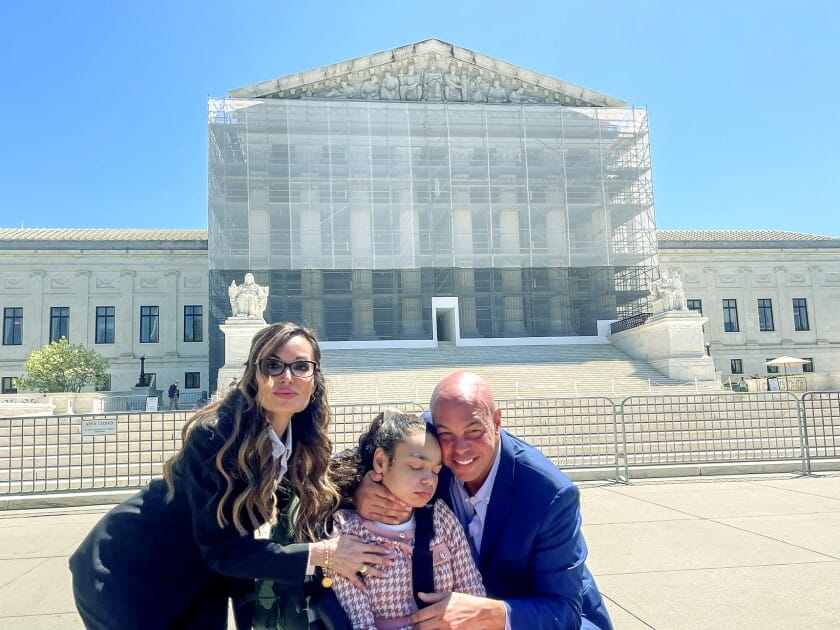The U.S. Supreme Court on Thursday sided with students with disabilities, overturning a lower-court ruling that had required them to meet a more stringent standard of liability when suing their schools under two key federal disability-discrimination laws.
The unanimous decision in A.J.T. v. Osseo Area Schools makes it easier for students and families to seek monetary damages for alleged discrimination under Section 504 of the Rehabilitation Act of 1973 and the Americans with Disabilities Act of 1990.
“We hold today that ADA and Rehabilitation Act claims based on educational services should be subject to the same standards that apply in other disability discrimination contexts,” and not a “distinct, more demanding analysis,” Chief Justice John G. Roberts Jr. wrote for the court.
“That our decision is narrow does not diminish its import for A.J.T. and a great many children with disabilities and their parents,” the chief justice said. “Together they face daunting challenges on a daily basis. We hold today that those challenges do not include having to satisfy a more stringent standard of proof than other plaintiffs to establish discrimination” under the two federal laws.
Student’s request for extended school hours sparked the case
The case centers on Minnesota student Ava Tharpe, who has a rare and severe form of epilepsy called Lennox-Gastaut Syndrome. The condition causes near-daily seizures, especially in the mornings and late evenings, making it unsafe for her to attend school before noon.
Her previous school district in Kentucky accommodated that need with a noon to 6 p.m. school day, sometimes supplemented with at-home instruction. But after the family moved to the Minneapolis area and Ava enrolled in the 18,600-student Osseo Area school district, officials told the family that it could not offer the same accommodations.
During her first three years in the Osseo district, Ava received only 4.25 hours of instruction per day, about two-thirds of the time other students without disabilities received, according to court filings.
The district argued that state law did not require a modified school schedule, that home instruction might be too restrictive, and that providing longer hours could set a precedent they were unwilling to establish.
The Tharpes filed a complaint with the Minnesota education department under the Individuals with Disabilities Education Act, the main federal special education law, and the basis for Tharpe’s individualized education program. A judge ordered the Osseo district to revise Tharpe’s IEP to 5.75 hours of instruction per day, including early-evening hours.
The Tharpes then sued under the Rehabilitation Act and the ADA, seeking a permanent injunction guaranteeing their daughter a full school day, as well as monetary damages for the years of alleged mistreatment and the family’s out-of-pocket costs of hiring support specialists.
Both a federal district court and the U.S. Court of Appeals for the 8th Circuit, in St. Louis, ruled against the family. They cited a 1982 decision by the 8th Circuit, Monahan v. Nebraska, which required students to prove a school district had acted with “bad faith or gross misjudgment.” That’s a significantly higher burden of proof than the negligence or deliberate-indifference standards typically applied under the two federal disability laws.
Courtesy of the Tharpe family
Lawyers for the Tharpes argued to the Supreme Court, among other things, that a 1984 amendment to IDEA clarified that the statute does not limit remedies under other federal laws.
Lawyers for the school district argued that Congress did not intend to provide for federal discrimination liability, including for money damages, over “countless good-faith decisions by every public school in America.”
School groups including AASA, the School Superintendents Association; the National School Boards Association; and the Council of Administrators of Special Education; filed a friend-of-the-court brief in support of the Osseo district, arguing that a ruling for the student would expand disability litigation against districts and result in “significant pains” in terms of financial resources.
Justices push back on the district’s broader argument
Roberts declined the school district’s argument that a more stringent standard of “bad faith or gross misjudgment” across the board in ADA and Rehabilitation Act suits. The issue was not resolved in lower courts in this case, and it would be unfair at this point to allow the school district to “switch gears” with its broader argument, he said.
Justice Clarence Thomas, in a concurrence joined by Justice Brett M. Kavanaugh, said that he agreed the district’s arguments on the higher standard were not properly presented in the Tharpe case but that he would consider those arguments in an appropriate case.
Justice Sonia Sotomayor, in a concurrence joined by Justice Ketanji Brown Jackson, said the school district’s argument was foreclosed by the statutes’ text and history, as well as court precedents.
The district’s “proposed improper-purpose requirement would … eviscerate the core of both the ADA and Rehabilitation Act, leaving millions of our fellow citizens without the protections Congress intended.”
Roman Martinez, a lawyer for the firm of Latham & Watkins who argued the case for the student said the decision was “a great win for Ava, and for children with disabilities facing discrimination in schools across the country.”
“This outcome gets the law exactly right, and it will help protect the reasonable accommodations needed to ensure equal opportunity for all,” Martinez said.
2025-06-12 17:50:08
Source link

